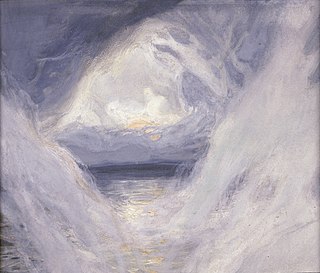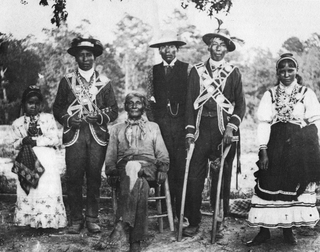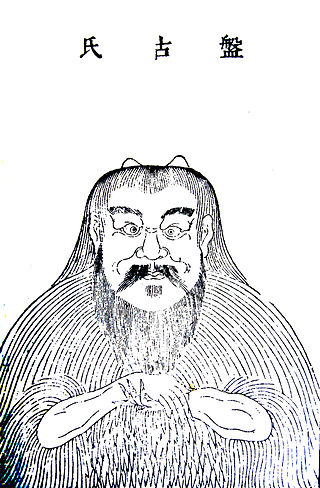Related Research Articles

A creation myth or cosmogonic myth is a type of cosmogony, a symbolic narrative of how the world began and how people first came to inhabit it. While in popular usage the term myth often refers to false or fanciful stories, members of cultures often ascribe varying degrees of truth to their creation myths. In the society in which it is told, a creation myth is usually regarded as conveying profound truths – metaphorically, symbolically, historically, or literally. They are commonly, although not always, considered cosmogonical myths – that is, they describe the ordering of the cosmos from a state of chaos or amorphousness.

In Norse mythology, Ymir, also called Aurgelmir, Brimir, or Bláinn, is the ancestor of all jötnar. Ymir is attested in the Poetic Edda, compiled in the 13th century from earlier traditional material, in the Prose Edda, written by Snorri Sturluson in the 13th century, and in the poetry of skalds. Taken together, several stanzas from four poems collected in the Poetic Edda refer to Ymir as a primeval being who was born from Eitr, yeasty venom that dripped from the icy rivers called the Élivágar, and lived in the grassless void of Ginnungagap. Ymir gave birth to a male and female from his armpits, and his legs together begat a six-headed being. The grandsons of Búri, the gods Odin, Vili and Vé, fashioned the Earth from his flesh, from his blood the ocean, from his bones the mountains, from his hair the trees, from his brains the clouds, from his skull the heavens, and from his eyebrows the middle realm in which mankind lives, Midgard. In addition, one stanza relates that the dwarfs were given life by the gods from Ymir's flesh and blood.

The Sun and the Moon is an unipkaaqtuat, a story in Inuit folklore. The traditional explanation for the movement of the Sun and Moon through the sky is a brother and sister are constantly chasing each other across the sky. The story also explains the dappled gray appearance of the Moon as soot smeared on his face.

Choctaw mythology is part of the culture of the Choctaw, a Native American tribe originally occupying a large territory in the present-day Southeastern United States: much of the states of Mississippi, Alabama, and Louisiana. In the 19th century, the Choctaw were known to European Americans as one of the "Five Civilized Tribes" even though controversy surrounds their removal.
Zuni religion is the oral history, cosmology, and religion of the Zuni people. The Zuni are a Pueblo people located in New Mexico. Their religion is integrated into their daily lives and respects ancestors, nature, and animals. Because of a history of religious persecution by non-native peoples, they are very private about their religious beliefs. Roman Catholicism has to some extent been integrated into traditional Zuni religion.
Diné Bahaneʼ, is a Navajo creation story that describes the prehistoric emergence of the Navajo as a part of the Navajo religious beliefs. It centers on the area known as the Dinétah, the traditional homeland of the Navajo, and forms the basis of the traditional Navajo way of life and ceremony. Throughout the stories the importance of cardinal points and the number four are emphasized in multiple aspects.

Pangu is a primordial being and creation figure in Chinese mythology and Taoism who separated heaven and earth, and his body later became geographic features such as mountains and roaring water.

The world egg, cosmic egg or mundane egg is a mythological motif found in the cosmogonies of many cultures that is present in Proto-Indo-European culture and other cultures and civilizations. Typically, the world egg is a beginning of some sort, and the universe or some primordial being comes into existence by "hatching" from the egg, sometimes lain on the primordial waters of the Earth.

Philippine mythology is rooted in the many indigenous Philippine folk religions. Philippine mythology exhibits influence from Indonesian, Hindu, Muslim, Shinto, Buddhist, and Christian traditions.

Raven Tales are the traditional human and animal creation stories of the indigenous peoples of the Pacific Northwest Coast. They are also found among Athabaskan-speaking peoples and others. Raven stories exist in nearly all of the First Nations throughout the region but are most prominent in the tales of the Haida, Tsimshian, Tlingit and Tahltan people.
The Fifth World in the context of creation myths describes the present world as interpreted by several indigenous groups in the USA and Mexico. The central theme of the myth holds that there were four other cycles of creation and destruction that preceded the Fifth World. The creation story is taken largely from the mythological, cosmological, and eschatological beliefs and traditions of earlier Mesoamerican cultures.

Melanesian mythology refers to the folklore, myths, and religions of Melanesia, a region in Southwest Oceania that encompasses the archipelagos of New Guinea, the Torres Strait Islands, Solomon Islands, Vanuatu, New Caledonia and Fiji. The various mythologies consist primarily of the traditions of oral literature in the different populations of Melanesia. More recent aspects include the cargo cults born in the 20th century during the Pacific War.
Chinese creation myths are symbolic narratives about the origins of the universe, earth, and life. Myths in China vary from culture to culture. In Chinese mythology, the term "cosmogonic myth" or "origin myth" is more accurate than "creation myth", since very few stories involve a creator deity or divine will. Chinese creation myths fundamentally differ from monotheistic traditions with one authorized version, such as the Judeo-Christian Genesis creation narrative: Chinese classics record numerous and contradictory origin myths. Traditionally, the world was created on Chinese New Year and the animals, people, and many deities were created during its 15 days.

The mythology of the Miwok Native Americans are myths of their world order, their creation stories and 'how things came to be' created. Miwok myths suggest their spiritual and philosophical world view. In several different creation stories collected from Miwok people, Coyote was seen as their ancestor and creator god, sometimes with the help of other animals, forming the earth and making people out of humble materials like feathers or twigs.

Turtle Island is a name for Earth or North America, used by some Indigenous peoples, as well as by some Indigenous rights activists. The name is based on a creation story common to several Indigenous peoples of the Northeastern Woodlands of North America.

A cosmic ocean, primordial waters, or celestial river is a mythological motif that represents the world or cosmos enveloped by a vast primordial ocean. Found in many cultures and civilizations, the cosmic ocean exists before the creation of the Earth. From the primordial waters the earth and the entire cosmos arose. The cosmic ocean represents or embodies chaos.
Mbombo, also called Bumba, is the creator god in the religion and mythology of the Kuba people of Central Africa in the area that is now known as Democratic Republic of the Congo. In the Mbombo creation myth, Mbombo was a giant in form and white in color. The myth describes the creation of the universe from nothing.
The Tungusic creation myths are traditional stories of the creation of the world belonging to the Tungusic peoples of Siberia.
The Serer creation myth is the traditional creation myth of the Serer people of Senegal, the Gambia and Mauritania. Many Serers who adhere to the tenets of the Serer religion believe these narratives to be sacred. Some aspects of Serer religious and Ndut traditions are included in the narratives contained herein but are not limited to them.

Sibú is the primary deity in the Talamancan mythology of Costa Rica. He is the creator of Earth and humanity, god of wisdom, values, and indigenous customs. He is called Sibú by the Bribri and Cabécar, Sibö by the Teribe, and Zipoh by the Boruca.
References
- ↑ "Obiugri mütoloogiast I". www.folklore.ee. Retrieved 2018-08-31.